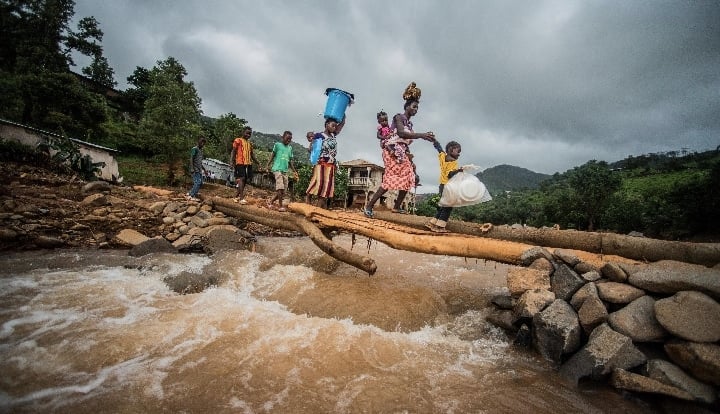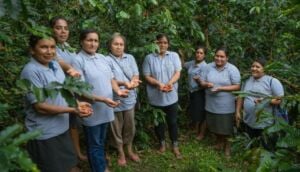Modern slavery is on the rise. New global estimates of modern slavery published in September 2022 found that almost 50 million people are in modern slavery, a rise of 10 million people since the previous estimates were released in 2017. This increase has been driven by the compounding crises of climate change, the COVID-19 pandemic, and armed conflicts.
In recent years, Anti-Slavery International has been working with our partners to establish the links between modern slavery and climate change. Research has shown that the impact of climate change is hitting hardest those who are already in precarious positions, such as women, children, indigenous people, and marginalised communities, increasing their vulnerability to modern slavery.
Yet, despite increasing debate on how to protect the world’s most vulnerable people from climate change, modern slavery rarely features in these debates. At Anti-Slavery International, we are working to get this on the global climate agenda, and we call upon the business community to join our efforts. To do so, businesses must recognise, understand and address how their own operations and value chains may be connected to the intersection of modern slavery and climate change. Below, we summarise four of the ways this can occur, and what considerations businesses should have to address this.
Four ways your business may be part of the intersection between climate change and modern slavery
- People forced to migrate due to both sudden environmental disasters, such as floods, and slow-onset climate events, such as droughts, become vulnerable to modern slavery. The World Bank has estimated that climate change could force over 200 million people to internally migrate by 2050. Increasing evidence is showing that in many cases the people and families pushed to migrate, both within and across borders, by climate change become vulnerable to exploitation, forced labour and trafficking. For example, in Bangladesh, families in the Sundarbans who have lost their agricultural livelihoods have been driven to migrate to urban settlements and are highly vulnerable to accepting exploitative work. It is highly likely that many of the victims of modern slavery, who end up in exploitation due to climate-induced migration, will be working in the value chains of global businesses. Specific vulnerable groups, including women, children, indigenous peoples, and marginalised communities, are perceived to face higher risks.
- Environmentally-damaging industries exacerbate climate change impacts, contributing to people becoming vulnerable to modern slavery. In many parts of the world, business models based on resource extraction and export-oriented agribusiness monopolise land and resources, polluting soil, air, and water, and destroying ecosystems. This exacerbates the pressure on local communities, particularly rural, peasant and indigenous communities who are dependent on natural resources or agricultural livelihoods, to migrate to survive and provide for their families. As above, often those pushed to migrate in these circumstances do so in conditions of vulnerability, exposing them to the risk of exploitation and modern slavery. Some of these migrants actually end up in forced labour in industries – directly and indirectly – that cause environmental devastation, creating a vicious circle.
- Modern slavery being used in environmentally degrading industries. It is well known that modern slavery is pervasive in some of the world’s most environmentally- and climate-damaging industries, such as Brazil where modern slavery is used to clear forests for cattle ranching, and the use of modern slavery in the palm oil industry, also a major driver of deforestation.
- Modern slavery in the renewable industry. Many of the industries crucial to our transition to clean energy are reliant on forced labour, such as to mine and process the materials used in electric cars and solar panels. For example, researchers at Sheffield Hallam University have established that almost the entire global solar panel industry is implicated in the forced labour of Uyghurs and other Turkic and Muslim-majority peoples in China.
What can businesses do?
As explained above, the intersection between climate change and modern slavery is complex and multifaceted. Aspects of it are increasingly recognised by some businesses – such as the use of modern slavery in the renewable industry. Yet the deeper picture, in which companies may be contributing or linked to modern slavery and climate-induced migration, is scarcely understood by governments or businesses alike.
Companies seeking to centre people at the heart of climate justice must consider people’s vulnerability to modern slavery within this action. This requires human rights and environmental due diligence which assesses questions like the following, to identify and address the risks relating to climate change and modern slavery:
- Which people and communities in my business and supply chain are most vulnerable to modern slavery as a result of climate change?
- Will the negative environmental and climate impact of my business and supply chain risk vulnerable people losing their livelihoods and resources?
- Is my business operating in, at any stage of its value chain, a location with a high influx of migrants as a result of climate change?
- Are the businesses’ climate commitments, such as use of renewable energies, taking account of human rights risks and impacts?
- Is my business credibly committed to a just transition? The transitions our societies make need to be just and fair: we cannot afford to leave people vulnerable to slavery as a result of crucial work to tackle climate change.
These are just the starting points for businesses to consider the intersection between modern slavery and climate change, yet it is urgent that this work begins. The world cannot properly tackle climate change without including efforts to end modern slavery.
To read more about Anti-Slavery International’s work on climate change and modern slavery, visit our website here.










